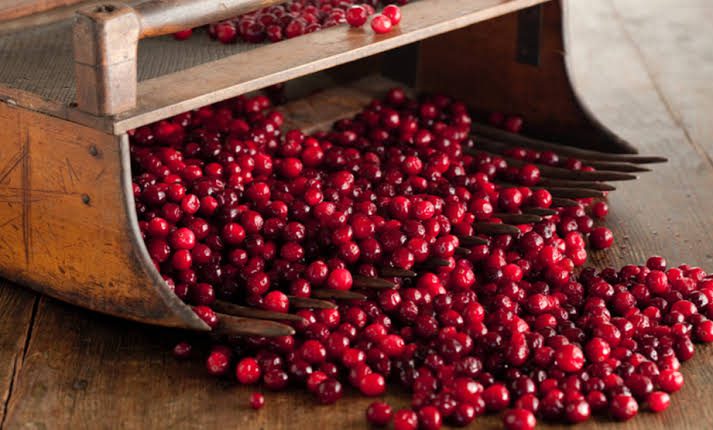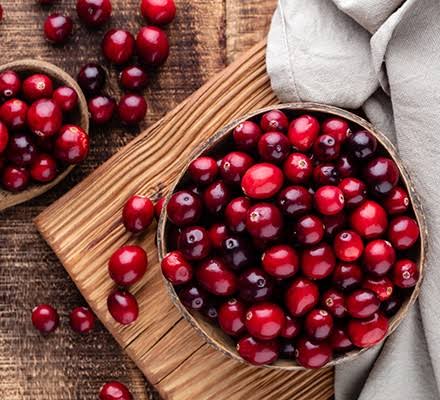Cranberries which is scientifically known Vaccinium macrocarpon are small round fruits that grow on vines in wet, marshy areas. These vibrant red berries are not only delicious but also packed with health benefits.
The taste of cranberries is unique – a delightful combination of tartness and sweetness. People often enjoy them in various forms, such as juices, sauces, and dried snacks. The versatility of cranberries makes them a favorite ingredient in both sweet and savory dishes.
One remarkable feature of cranberries is their high vitamin C content. Vitamin C is essential for a healthy immune system, helping the body fight off infections and stay strong. Incorporating cranberries into your diet is a tasty way to boost your vitamin C intake.
Beyond their taste and nutritional value, cranberries have gained recognition for their potential role in urinary tract health. Some studies suggest that the compounds in cranberries may help prevent certain bacteria from sticking to the walls of the urinary tract, reducing the risk of infections.
Cranberries are also celebrated for their antioxidant properties. Antioxidants play a crucial role in protecting our cells from damage caused by free radicals. Including cranberries in your diet may contribute to overall well-being by supporting your body’s defense against oxidative stress.
In addition to their health benefits, cranberries have a fascinating history. Native to North America, they were used by Indigenous peoples for various purposes, including as a food source, medicine, and even dye for clothing. European settlers later adopted cranberries into their culinary traditions, leading to the widespread popularity of cranberry-based dishes.
Cranberry harvesting is a unique process. The berries are typically grown in bogs or wetlands and are often flooded during harvest. This allows the berries to float to the surface, making them easier to collect. The picturesque sight of cranberry bogs during harvest season has become an iconic image associated with these festive red berries.
In addition, cranberries are more than just a tasty addition to your meals. They are a nutritional powerhouse, offering a burst of flavor along with potential health benefits. Whether enjoyed fresh, dried, or in various culinary creations, cranberries continue to captivate taste buds and contribute to a healthy lifestyle.
Read Also: Economic Importance and Uses of Hen Eggs
History of Cranberries (Vaccinium macrocarpon)

The history of cranberries traces back to the native lands of North America, where Indigenous peoples first discovered and utilized these vibrant red berries. Long before European settlers arrived, Native Americans recognized the value of cranberries as a versatile resource.
Indigenous communities used cranberries not only as a food source but also for medicinal purposes. The berries were believed to have healing properties, and various parts of the plant were employed to address ailments. Additionally, cranberries served as a natural dye for clothing, showcasing the resourcefulness of these communities in utilizing the berries in multiple aspects of daily life.
When European settlers arrived in North America, they encountered cranberries and quickly recognized their potential. The settlers integrated cranberries into their culinary traditions, creating a foundation for the popularity of cranberry-based dishes that persists to this day.
Cranberry cultivation expanded as European settlers established farms and adapted growing techniques to suit the berries’ unique requirements. Over time, cranberries became a staple in the diets of early American communities, finding their way into sauces, jams, and various recipes.
The commercial cultivation of cranberries took off in the 19th century, with farmers refining growing methods and recognizing the need for efficient harvesting. The flooding of cranberry bogs during harvest season became a notable practice, as it allowed the berries to float, making them easier to collect.
The cranberry industry continued to grow, and by the early 20th century, cranberries became a significant agricultural commodity. Cranberry festivals and celebrations emerged, highlighting the cultural and economic importance of these berries in various regions.
Today, cranberries are not only a traditional part of holiday meals but also a year-round favorite in a variety of dishes and products. The rich history of cranberries reflects the resilience and adaptability of these berries, from their indigenous roots to their widespread cultivation and consumption worldwide.
Nutritional Value of Cranberries (Vaccinium macrocarpon)
Cranberries are more than just flavorful; they offer a range of essential nutrients that contribute to a well-balanced diet. Here’s a glimpse into the nutritional profile of these vibrant red berries:
1. Vitamin C: Cranberries are a excellent source of vitamin C, a vital nutrient that supports the immune system, promotes healthy skin, and aids in the absorption of iron.
2. Fiber: These berries are rich in dietary fiber, which is beneficial for digestive health. Fiber helps regulate bowel movements and may contribute to a feeling of fullness, aiding in weight management.
3. Antioxidants: Cranberries are packed with antioxidants, including flavonoids and polyphenols. These compounds play a crucial role in neutralizing free radicals, protecting cells from oxidative damage.
4. Vitamin E: While present in smaller amounts compared to vitamin C, cranberries also contain vitamin E, which contributes to skin health and acts as an antioxidant in the body.
5. Vitamin K: Cranberries provide a modest amount of vitamin K, essential for blood clotting and bone health.
6. Manganese: Cranberries contain manganese, a trace mineral that supports bone formation, blood clotting, and reduces inflammation.
7. Copper and Potassium: These minerals are found in cranberries in smaller amounts but play roles in maintaining a healthy cardiovascular system and aiding in nerve function.
It’s important to note that many of these nutrients, especially antioxidants, are more concentrated in fresh or minimally processed cranberries. However, cranberry products, such as juices and dried cranberries, still retain significant nutritional value.
Incorporating cranberries into your diet can be a flavorful way to boost your intake of these essential nutrients and promote overall health and well-being. Whether enjoyed fresh, dried, or as part of various dishes, cranberries offer a tasty and nutritious addition to a balanced eating plan.
Read Also: Economic Importance and Uses of Turkey Meat
Health Benefits of Cranberries (Vaccinium macrocarpon)

Cranberries offer a range of health benefits, making them a nutritious addition to your diet. Here are some key advantages associated with the consumption of cranberries:
1. Urinary Tract Health: Cranberries are renowned for their potential to support urinary tract health. Compounds in cranberries may prevent certain bacteria from adhering to the urinary tract walls, reducing the risk of urinary tract infections (UTIs).
2. Rich in Antioxidants: The antioxidants in cranberries play a crucial role in protecting cells from oxidative stress. This can contribute to overall well-being by reducing the risk of chronic diseases and promoting healthy aging.
3. Heart Health: Some studies suggest that regular consumption of cranberries may have cardiovascular benefits. Antioxidants and anti-inflammatory properties may contribute to lower blood pressure and improved cholesterol levels.
4. Digestive Health: The dietary fiber in cranberries supports digestive health by promoting regular bowel movements and preventing constipation. Adequate fiber intake is essential for a healthy digestive system.
5. Immune System Support: The high vitamin C content in cranberries is known to boost the immune system, helping the body fend off infections and illnesses. A robust immune system is crucial for overall health and well-being.
6. Cancer Prevention: While more research is needed, some studies suggest that the antioxidants in cranberries may have anti-cancer properties. These antioxidants may help protect cells from damage that can lead to the development of cancer.
7. Dental Health: Cranberries contain certain compounds that may help prevent the adhesion of bacteria, including those associated with dental plaque. This property could contribute to improved oral health and a lower risk of cavities.
8. Weight Management: The fiber in cranberries can contribute to a feeling of fullness, potentially aiding in weight management by reducing overall calorie intake.
It’s important to note that while cranberries offer numerous health benefits, they are most effective as part of a balanced and varied diet. Including a variety of nutrient-rich foods along with cranberries can contribute to optimal health and well-being.
How to Grow Cranberries (Growing Guide)
Growing cranberries can be a rewarding endeavor, and though they have specific requirements, following a few key steps can lead to a successful harvest. Here’s a basic guide to growing cranberries:
1. Choose the Right Variety: Select a cranberry variety suitable for your climate and soil conditions. Common varieties include Stevens, Ben Lear, and Early Black.
2. Site Selection: Cranberries thrive in acidic, sandy, and peat-rich soils. Ensure proper drainage to prevent waterlogging, and consider a location with full sunlight exposure.
3. Planting: Cranberries are usually planted in spring or early summer. They can be grown from seeds, cuttings, or more commonly, from established plants known as “runners.”
Plant the runners in rows with spacing based on the variety and cultivation method you choose.
4. Irrigation: Cranberries require consistent moisture, especially during the growing season. The traditional “wet harvesting” method involves flooding the fields during harvest, but regular irrigation is essential for optimal growth.
5. Pruning: Regular pruning helps maintain the health and vigor of cranberry plants. Remove dead or diseased vines and control excessive growth to promote better air circulation.
6. Frost Protection: Cranberries are sensitive to frost, especially during the flowering period. Implement frost protection measures such as sprinkler systems to prevent damage to blossoms.
7. Fertilization: Use fertilizers formulated for acidic-loving plants. Apply fertilizers in the spring before new growth begins, following package instructions for rates and timing.
8. Weed Control: Keep the cranberry bed free from weeds, as they can compete for nutrients and water. Mulching with sawdust or straw helps control weeds and conserve moisture.
9. Harvesting: Cranberries are typically ready for harvest in the fall. For wet harvesting, flood the cranberry bog, and then use specialized equipment to collect the floating berries.
Dry harvesting involves using mechanical pickers to collect ripe berries without flooding the fields.
10. Storage: Store harvested cranberries in a cool and dry place. Cranberries have a relatively long shelf life, especially when refrigerated or frozen.
Remember that cranberry cultivation often requires specific conditions, and it’s advisable to consult local agricultural extension services or cranberry farming experts for guidance tailored to your specific region. Following these general guidelines, along with regional considerations, can set you on the path to successfully growing these vibrant red berries.
Read Also: The Different Types of Fertilizers and How they Work
